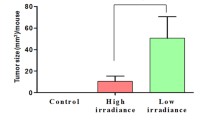Abstract
Both high-intensity ultraviolet and narrowband ultraviolet B (NB-UVB) are important therapeutic options for vitiligo management, but high-intensity ultraviolet is more effective than NB-UVB. However, the underlying mechanisms have not been well investigated. Herein, we compare the effects of high-intensity ultraviolet and NB-UVB on the pigmentation of melanocytes derived from hair follicle-derived neural crest stem cells (HF-NCSCs) in vitro and study the underlying mechanisms. The HF-NCSCs were isolated from mouse whisker follicles. After radiation with high-intensity ultraviolet and NB-UVB, respectively, the cell viability by the CCK-8 assay showed gradual inhibitory effects in a dose-dependent manner, which has no apparent difference between the two modalities. The mRNA for melanogenesis factors such as tyrosinase and tyrp1 of the differentiated melanocytes increased significantly with high-intensity ultraviolet compared to the same dose of NB-UVB exposure. Furthermore, the expression of Mc1r was significantly increased by high-intensity ultraviolet in contrast to NB-UVB at the dosage of 0.5 J. By and large, these data suggest that high-intensity ultraviolet exhibited greater efficiency on the maturation of the melanocyte lineage differentiated from HF-NCSCs compared to NB-UVB with the same dose, which was probably due to the stronger stimulatory action of Mc1r. This may provide new insights into the different efficacies of high-intensity ultraviolet and NB-UVB in the treatment of vitiligo repigmentation.




Similar content being viewed by others
References
Asawanonda P, Kijluakiat J, Korkij W et al (2008) Targeted broadband ultraviolet b phototherapy produces similar responses to targeted narrowband ultraviolet B phototherapy for vitiligo: a randomized, double-blind study. Acta Derm Venereol 88:376–381
Asawanonda P, Charoenlap M, Korkij W (2006) Treatment of localized vitiligo with targeted broadband UVB phototherapy: a pilot study. Photodermatol Photoimmunol Photomed 22:133–136
Akar A, Tunca M, Koc E et al (2009) Broadband targeted UVB phototherapy for localized vitiligo: a retrospective study. Photodermatol Photoimmunol Photomed 25:161–163
Pacifico A, Leone G (2011) Photo(chemo)therapy for vitiligo. Photodermatol Photoimmunol Photomed 27:261–277
Vanscheidt W, Hunziker T (2009) Repigmentation by outer-root-sheath-derived melanocytes: proof of concept in vitiligo and leucoderma. Dermatology 218:342–343
Nishimura EK, Jordan SA, Oshima H et al (2002) Dominant role of the niche in melanocyte stem-cell fate determination. Nature 416:854–860
Nishimura EK, Granter SR, Fisher DE (2005) Mechanisms of hair graying: incomplete melanocyte stem cell maintenance in the niche. Science 307:720–724
Yu H, Fang D, Kumar SM et al (2006) Isolation of a novel population of multipotent adult stem cells from human hair follicles. Am J Pathol 168:1879–1888
Dong D, Jiang M, Xu X et al (2012) The effects of NB-UVB on the hair follicle-derived neural crest stem cells differentiating into melanocyte lineage in vitro. J Dermatol Sci 66:20–28
Tanimura S, Tadokoro Y, Inomata K et al (2011) Hair follicle stem cells provide a functional niche for melanocyte stem cells. Cell Stem Cell 8:177–187
Yamaguchi Y, Hearing VJ (2009) Physiological factors that regulate skin pigmentation. Biofactors 35:193–199
Osawa M, Egawa G, Mak SS et al (2005) Molecular characterization of melanocyte stem cells in their niche. Development 132:5589–5599
Wegner M (2005) Secrets to a healthy Sox life: lessons for melanocytes. Pigment Cell Res 18:74–85
Hou L, Arnheiter H, Pavan WJ (2006) Interspecies difference in the regulation of melanocyte development by SOX10 and MITF. Proc Natl Acad Sci U S A 103:9081–9085
Murisier F, Guichard S, Beermann F (2007) The tyrosinase enhancer is activated by Sox10 and Mitf in mouse melanocytes. Pigment Cell Res 20:173–184
Levy C, Khaled M, Fisher DE (2006) MITF: master regulator of melanocyte development and melanoma oncogene. Trends Mol Med 12:406–414
Chou WC, Takeo M, Rabbani P et al (2013) Direct migration of follicular melanocyte stem cells to the epidermis after wounding or UVB irradiation is dependent on Mc1r signaling. Nat Med 19:924–929
Swope VB, Jameson JA, McFarland KL et al (2012) Defining MC1R regulation in human melanocytes by its agonist α-melanocortin and antagonists agouti signaling protein and β-defensin 3. J Invest Dermatol 132:2255–2262
Newton RA, Roberts DW, Leonard JH et al (2007) Human melanocytes expressing MC1R variant alleles show impaired activation of multiple signaling pathways. Peptides 28:2387–2396
Maresca V, Flori E, Bellei B et al (2010) MC1R stimulation by alpha-MSH induces catalase and promotes its re-distribution to the cell periphery and dendrites. Pigment Cell Melanoma Res 23:263–275
Conflict of interest
The authors declare that they have no conflict of interest.
Author information
Authors and Affiliations
Corresponding author
Additional information
D. Dong and S. Chen contributed equally as co-first authors to the article.
Rights and permissions
About this article
Cite this article
Dong, D., Chen, S., Zhang, X. et al. Comparison of high-intensity ultraviolet and NB-UVB on the maturation of melanocytes derived from hair follicle neural crest stem cells. Lasers Med Sci 29, 1649–1654 (2014). https://doi.org/10.1007/s10103-014-1568-6
Received:
Accepted:
Published:
Issue Date:
DOI: https://doi.org/10.1007/s10103-014-1568-6




